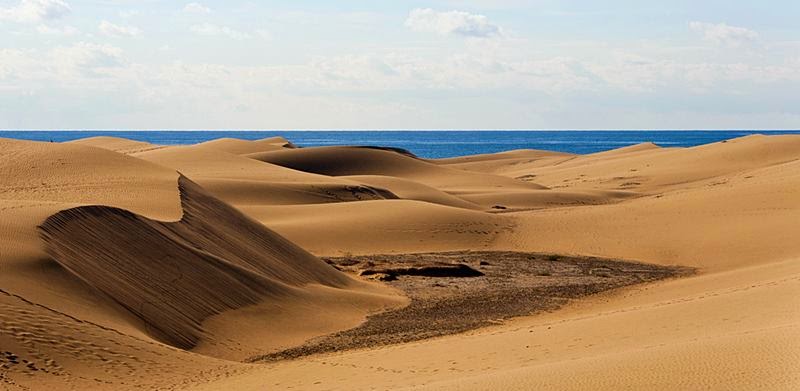Maspalomas Dunes in Spanish Dunas de Maspalomas are one of the most picturesque places in Gran Canaria, Las Palmas, in the Canary Islands, representing a piece of sandy desert, which spreads over 4 km along the coastal area of the island. The sand originated from coral reefs crushed into reasonable golden grains of limestone by the grinding action of glaciers approximately more than thousands of years ago. The present ocean dragged them to the shore and ultimately wind accumulated them into dunes.
 |
| Maspalomas Dunas |
Maspalomas Dunas
This site is in close proximity to the eponymous town and attracts many tourists. Around the tower, comfortable hotels and beautiful green lawn for golf lovers are so revered aristocratic sport. The dunes are constantly moving, although the movement is absolutely unnoticeable to the eye and is several meters per year. Against the background of azure-blue waters of the Atlantic Sands look extremely colorful in different seasons and together form an incredibly beautiful picture painted by nature. The sand of the more than 32-ft (10 m) high dunes was not blown over from the Sahara - as often presumed – but has maritime origins; it is made of finely ground lime shells of mussels.
Maspalomas Dunes are the result of crushed coral in the sand, due to the natural chaos caused by the ice age. Since 1994, Maspalomas has got the status of a nature reserve of 403 hectares, which continues inland another outstanding park Gran Canaria - La Charco. There remained a unique lake, under pressure dunes periodically changes its coastline.
Dunas de Maspalomas
Reserva Natural Especial de Las Dunas de Maspalomas
The Beach area is somewhere equipped with sun loungers, umbrellas, and showers, but there are wild places for fans of classic holidays in peace and quiet, in the absence of infrastructure. Sand, especially in the middle of the day, is very hot, so you should take with beach shoes. Maspalomas Dunes are certainly worthy of special attention, and definitely worth it to give them a little time during your stay on the island of Gran Canaria.
At the western end of this nature reserve, you’ll find El Oasis, which is bordered by La Charca, the remains of a sea-water lagoon bordered with palm trees, hosting many species of migratory birds from Europe stopping here on their route to Africa.
First Image credit El Coleccionista de Instantes
 |
| Maspalomas dunes |
Image credit roba66
 |
| Natural dune reserve of Maspalomas |
Image credit McDaveHamburg
 |
| Reserva natural especial de Las Dunas de Maspalomas |
Image credit Michal Sleczek
 |
| Dunas Maspalomas |
Image credit Michele Solmi
 |
| Maspalomas Spanien |
Image credit draculina_ak
 |
| Las Dunas Maspalomas Gran Canaria |
Image credit Matilda Diamant
 |
| Gran Canaria Dunes |
Image credit roba66
 |
| Maspalomas dunas |
Image credit Bard Ove Myh
 |
| Maspalomas sand dune |
Image credit El Coleccionista de Instantes
Where is Maspalomas
 |
| Maspalomas dunes |
Image credit Bard Ove Myhr

OK, VERY NICE YOU SEND FOR ME
ReplyDelete